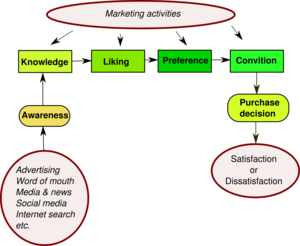Hierarchy of effects model
| Hierarchy of effects model |
|---|
| See also |
Hierarchy of effects model (or so called AKLPCP Lavidge and Steiner model) is one of the models for customer response hierarchy to the various forms of media advertising. The model is based on the concept of conscious learning, where the potential customer (the person characterized by significant commitment to obtain product information) meets his needs by buying the best available product. It assumes that target group of customers is heavily involved in a given product category, however, they see product differentiation within the category as non existent.
Assumptions
The fundamental proposition for most models of reaction hierarchy is that the impact of advertising on potential customers is gradual process which comes down to three basic phases: cognitive (perception), emotional (information processing) and behavioural (actual buying decision). The sequence of stages is always the same, end there are strong causal links between them.
Hierarchy of effects proposed by Lavidge and Steiner assumes that the consumer can pass through some stages faster, slower, or can also move through several stages at once, as each phase of the hierarchy must not be separated from each other by identical time distances. The model also assumes that the buyer first gaining knowledge of the desired product, then under the influence of the information shapes his attitudes and perceptions about the product, and finally decide whether to buy or not.
Model construction
Hierarchy of effects include six successive stages of forming the acronym AKLPCP:
- Awareness - The task of the advertising message sender is to build awareness of the subject (or at least ability to recognize a particular brand) among a large part of the target group, if there is no such previous awareness. This objective can be achieved through simple messages, which will repeat product or brand name.
- Knowledge - The target group in addition to awareness of product existence must have adequate knowledge about it. The advertising message sender must verify the degree of knowledge possessed by the audience. In the case of a small knowledge of the product, the sender can decide that the primary purpose of the communication process will be to build knowledge of the product.
- Liking (fondness, delight) - Sender should check what emotions are aroused by the product among consumers who know about it. In the case of the negative opinion, sender's job is to understand the reasons for this condition.
- Preference - The product can appeal to the target audience on a par with other items available on the market (i.e. offered by competition). This situation requires the sender to try creating a consumer preference for its product. This objective can be achieved by promoting quality, values, performance indicators and other relevant characteristics of advertised product. The success of the advertising campaign can be monitored by measuring the preferences of customers after its completion.
- Conviction - The product may be preferred by the target group, which, however, is not convinced to purchase it. The advertising message sender is required to create the belief among consumers that the advertised product is the best choice possible.
- Purchase - Part of the target audience can be convinced to the product offered, but not fully ready for making actions necessary for its acquisition. Potential buyers can wait for additional information, or decide to postpone purchase decision in time. Sender's task is to bring the audience to make a decision via price reductions, promotions, the opportunity to try the product before buying.
References
- Barry, T. E. (1987). The development of the hierarchy of effects: An historical perspective. Current issues and Research in Advertising, 10(1-2), 251-295.
- Lavidge, R. J., & Steiner, G. A. (2000). A model for predictive measurements of advertising effectiveness. Advertising & Society Review, 1(1).
- Palda, K. S. (1966). The hypothesis of a hierarchy of effects: A partial evaluation. Journal of Marketing Research, 13-24.
- Tauber, E. M. (1973). Reduce new product failures: measure needs as well as purchase interest. The Journal of Marketing, 61-64.
Author: Krzysztof Wozniak
